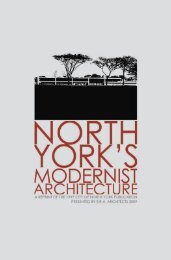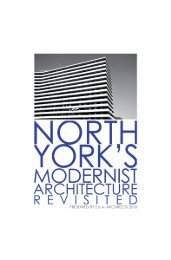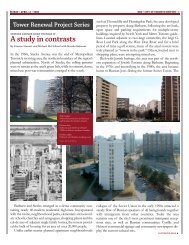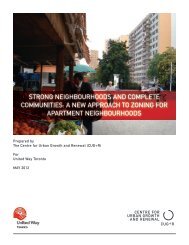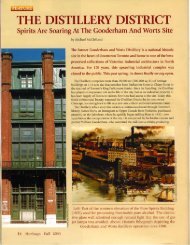concrete toronto the modern suburbs - ERA Architects Inc.
concrete toronto the modern suburbs - ERA Architects Inc.
concrete toronto the modern suburbs - ERA Architects Inc.
You also want an ePaper? Increase the reach of your titles
YUMPU automatically turns print PDFs into web optimized ePapers that Google loves.
The Age of Modern High-Rise Construction<br />
Ivan Saleff<br />
Architect, Assistant Professor, Faculty of Architecture, Landscape and Design, University of Toronto<br />
‘We must create <strong>the</strong> mass-production spirit.The spirit of<br />
constructing mass-production houses. The spirit of living<br />
in mass-production houses. The spirit of conceiving massproduction<br />
houses.’<br />
Le Corbusier, Vers Une Architecture, 1923<br />
The esprit nouveau Le Corbusier championed<br />
so long ago, during <strong>the</strong> age of <strong>the</strong> machine, was<br />
ironically reincarnated in <strong>the</strong> space age. The<br />
purist paradox of classical formalism married<br />
with contemporary technologies and modes of<br />
production was to redefine affordable shelter<br />
in Toronto. The sublime non-stylistic aes<strong>the</strong>tic<br />
of Canadian poured-<strong>concrete</strong> grain elevators<br />
that so inspired Le Corbusier would thrive in this<br />
post-Levittown age.<br />
Fig. 7. Thorncliffe Park under construction<br />
218<br />
ARTICLES<br />
The Jetsons were on TV, Yorkville was electric,<br />
Neil was young, McLuhan was in fine form,<br />
Revell’s City Hall design materialized complete<br />
with Moore’s Archer, and <strong>the</strong> Beatles, <strong>the</strong> Stones<br />
and Zeppelin were in <strong>the</strong> air. The Maple Leafs<br />
were a dynasty. While our siblings south of <strong>the</strong><br />
border experienced <strong>the</strong> ’60s as turbulent times,<br />
Toronto optimistically embraced <strong>the</strong> decade as<br />
<strong>the</strong> beginning of a new world. A variety of lifestyle<br />
choices offering new directions appeared.<br />
High-rise living was one of <strong>the</strong>m.<br />
Not since mountainside cave dwellings had such<br />
panoramic views from one’s home been available.<br />
Autos were neatly stabled in <strong>the</strong> <strong>concrete</strong><br />
belly of <strong>the</strong> tower, with speedy elevators on<br />
hand to transport occupants to <strong>the</strong>ir homes<br />
above. Swimming pools, landscaping, furnished<br />
lobbies, inspired entry canopies and multi-purpose<br />
rooms were among <strong>the</strong> amenities helping<br />
to convey a perception of luxury <strong>modern</strong> living.<br />
For a 20-year period beginning in <strong>the</strong> early ’60s,<br />
high-rise living embedded itself in Toronto’s<br />
housing consciousness. A rare alliance occurred<br />
of unprecedented population growth and market<br />
demand, affordable urban and suburban sites,<br />
demographic characteristics, planning policies,<br />
opportunistic developers, a robust labour force<br />
and new technologies. This fertile scenario was<br />
in great part anchored by an ancient recipe of<br />
water, sand, cement, aggregate and slender steel<br />
rods. Reinforced <strong>concrete</strong> structure became <strong>the</strong><br />
system of choice.<br />
The technology of <strong>the</strong> reinforced eight-inch<br />
<strong>concrete</strong> one-way slab and shear wall construction<br />
provided <strong>the</strong> city’s residential high-rises<br />
with highly efficient and durable armatures.<br />
GUIDEBOOK No. 45<br />
Fig. 8. Thorncliffe Park emerging from <strong>the</strong> Don Valley<br />
The simple redundant six-metre spans complemented<br />
both unit layouts and below-grade parking.<br />
The introduction of flying-form technology,<br />
coupled with advancements in crane design,<br />
generated taller buildings. Twenty storeys high,<br />
200 units, with two levels of below-grade parking,<br />
became a standard.<br />
Rectangular slabs, square point towers, Y-shaped<br />
and cruciform plan typologies began to appear<br />
all over Toronto’s urban and suburban horizon.<br />
The subsequent increase in living units relative<br />
to building footprint dramatically reduced<br />
construction costs on a per-unit basis. Substantial<br />
densities were achieved with relatively compact<br />
footprints. Le Corbusier’s idealistic vision<br />
was to replace cramped, antiquated Parisian<br />
slums with 20th-century shelter, elevating <strong>the</strong><br />
quality of life of its inhabitants. The agenda of our<br />
space-age megaliths was less altruistic – ra<strong>the</strong>r a<br />
rapid response to enormous demand.<br />
Concrete Toronto | THE MODERN SUBURBS<br />
These ordinary, underappreciated, aging megaliths<br />
may once again transform Toronto’s horizon.<br />
Their sturdy poured-<strong>concrete</strong> skeletons for<br />
<strong>the</strong> most part are still in <strong>the</strong> early stages of <strong>the</strong>ir<br />
life cycle. Their solid-masonry exterior walls<br />
and infrastructure have, however, reached a<br />
durability threshold. Contemporary environmentally<br />
responsive over-cladding and o<strong>the</strong>r<br />
strategies offer viable vehicles for rehabilitation<br />
and aes<strong>the</strong>tic transformation. (See Durability,<br />
page 314.)<br />
The present and future value of Toronto’s vintage<br />
high-rise housing inventory is indisputable. How<br />
such a seemingly monolithic construct, virtually<br />
medieval in its materiality, can continue to be<br />
relevant into <strong>the</strong> next century is a testimony to<br />
both <strong>the</strong> durability of <strong>the</strong> typology and its system<br />
of choice.<br />
Concrete Toronto 27 09 07.indd 1218-1219 9/28/07 10:41:05 AM<br />
219




